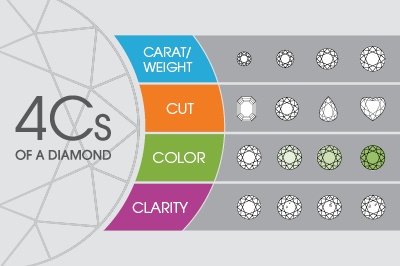
If you are a jeweler, you know that diamond jewelry is one of the most popular types of jewelry. Aside from the common emotional symbolism that would compel a customer to buy a diamond piece, such as love, elegance, beauty, and wealth, there are real nuts-and-bolts associated with the value of a diamond that must be conveyed to them too – the 4Cs. The 4Cs serve as a sort of “user-friendly” acronym that helps customers better understand what to look for when making a purchase.
The 4Cs (Carat, Cut, Color and Clarity) is a value driven grading scale that compares a certain diamond to an equally sized perfect sample. It is important to educate your customers about the 4Cs for the sake of transparency. When investing in diamonds, customers are often concerned that they get their money’s worth, and helping them understand what goes into a diamond’s value is critical to allaying those concerns and instilling confidence in their purchase.
Learning how the 4Cs work together to create a unique diamond may well contribute to a customer’s perception of the diamond’s beauty. The challenge for diamond retailers is to educate their customers without overwhelming them with technical jargon, and to maintain the magic and mystic of the diamond’s natural beauty.
Carat – This is the measure of a diamond’s weight and thus its overall size. As larger diamonds are more rare, often diamond prices will increase as the carat weight increases, but this will also be dependent on the quality of the remaining 3 Cs. Larger diamonds can also highlight the properties of the other 3 Cs, both in terms of the potential for beauty and the risk of noticing flaws. Although large diamonds are idealized in modern day culture and celebrity, small diamonds can be just as valuable, especially when they are given with love and sentimentality.
Inform your customers that if their budget doesn’t allow for one large diamond, they can buy several smaller diamonds, which may add up to be equal in carat weight to the large diamond, but cost less in total. These smaller diamonds can be designed into beautiful, impactful, sparkling diamond jewelry and still stay within their budget.
Cut – Explain to your customers that a diamond’s cut is a mark of workmanship, and not an inherent quality of the diamond itself. However, a diamond’s cut is a most important characteristic. A well cut diamond reflects light from each of its facets internally, and then disperses that light through its top. The more facets a diamond has, the sharper and more brilliant the diamond appears, potentially redeeming a diamond that might have a lesser color or clarity.
Technically speaking, the diamond cut proportions, the relationship between the size, shape and angle of each diamond facet, is of utmost importance to the diamond’s overall appearance and balance. Share this information with your customers and inform them that a diamond’s cut is designed to reflect light to enhance a diamond’s beauty. This reflected light is perceived as brilliance (total facet-reflected light), dispersion (rainbow flashes within a diamond), and scintillation (sparkling flashes with movement).
Be sure to tell your customers, in the words of Russell Shor, of the Gemological Institute of America, “The one thing you should not trade off on is the quality of the cut, even a nice color stone, if not well cut, will be dull and lifeless. But if it’s a middle color – like K – and it’s got a real excellent cut, it will pop and flash with all the sparkle diamonds are famous for.”
Color – Diamonds come in a variety of colors, some of which, like blue, pink and green, are very rare and high in value. However, for white diamonds, the most valuable “color” actually approaches colorless. Customers may be surprised to realize how many subtle tints are visible when diamonds are viewed with the right lighting. Make it your job to help them see the range and depth of color within the diamond, and be advised that your words help make a stone appealing. For example, the experts in The Retailer’s Guide to Marketing Jewellery suggest that using the term “warm white” is much more appealing than saying “tinted yellow or brown.” And, of course, the customer is always right – someone who prefers a fancy colored diamond should be encouraged to find the pink or yellow stone that he or she likes best.
Clarity – Almost all diamonds contain small imperfections, and clarity measures the size and number of these imperfections. Many customers will want their diamonds to be flawless. But they should be informed that nearly every diamond has “inclusions” – the mineral traces that affect the clarity of the stone. Those inclusions that blend into the diamond’s color or are small enough to disappear except under the closest scrutiny have relatively little impact on a diamond’s value, while others have the potential to diminish a diamond’s durability or cannot be hidden in a jeweler’s setting. Blue Nile explains that, “Many of these imperfections are microscopic, and do not affect a diamond’s beauty in any discernible way.” Make this point clear to your customers, but support their decision if they wish to pursue a more perfect diamond.
Conclusion
As recommended by Amanda Gizzi, of Jewelers of America, diamond jewelers should first guide their customers to choose the right diamond cut and then help them to balance color, clarity and carat weight based on their personal preferences, so that they can find the best diamond for their budget. And remember, every diamond purchase is a special one and should be made to feel so.
Be sure to look out for our upcoming blogs about each of the 4Cs in more detail to gain more information and get more ideas about how to sell diamond jewelry to your customers. Read the next 4Cs blog on CUT.


 RapNet Blog
RapNet Blog